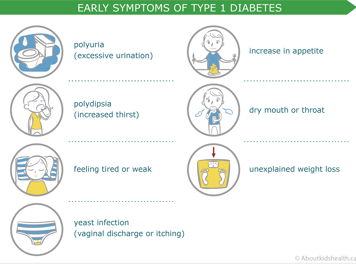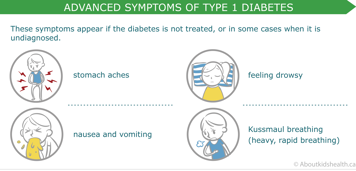Type 1 diabetes is a condition in which the pancreas stops producing insulin, an important hormone that helps control blood glucose (sugar) levels.
What happens to the pancreas with diabetes?
Type 1 diabetes is an autoimmune condition. In type 1 diabetes, the pancreas is attacked by the body’s defense system also known as the immune system. Normally the immune system helps protect our bodies by making antibodies, which are special proteins that fight off infection. In patients with type 1 diabetes, the body mistakenly makes antibodies that attack the beta cells in the pancreas, which produce insulin. Over time, more and more beta cells are damaged and less and less insulin is produced. This eventually leads to type 1 diabetes.
What are the signs and symptoms of type 1 diabetes?
When someone eats food or drinks fluids with carbohydrates , the carbohydrates are broken down (digested) and glucose (sugar) is released. This sugar travels through the bloodstream. Insulin opens up channels on the cell surface that let sugar in. For a child with type 1 diabetes, because the pancreas is unable to make insulin, insulin cannot help sugar move into the cells. When the sugar remains locked out of the cells, the child may become tired because the cells are starved for energy. Meanwhile, sugar continues to build up in the blood and the body tries to use other sources of energy, which can have harmful side effects.
The kidneys have the job of filtering blood and getting rid of substances that might otherwise harm the body. When the kidneys sense a high level of sugar in the blood, they start eliminating it through the urine.
- The excess sugar in the blood is transported to the kidneys from where it is peed out. As a result, the child urinates more often and in larger amounts just to get rid of the sugar. This is called polyuria.
- The higher the blood sugar level, the more often the child urinates. This often leads to dehydration, so the body demands more water, and the child becomes increasingly thirsty. This is called polydipsia.
Children may complain of a dry, sticky mouth or a sore, dry throat. Parents report children gulping down jugs of juice and large quantities of milk or water. Sometimes parents think their child is urinating so much because of the extra fluid that they are drinking, so they try to cut off the fluids. However, the child will continue to urinate often because the body’s priority is to clear out the excess sugar. Drinking all this fluid is the only way to avoid dehydration.
Excessive urination and thirst are usually the first indications of high blood sugar level typical of diabetes. Some children have to get up in the middle of the night to go to the bathroom to pee (nocturia).
Younger children may even start wetting the bed (enuresis). The loss of sugar in the urine, together with dehydration and the inability to use blood sugar for energy, will lead to the body looking for alternative sources of energy in the body. The body will begin to breakdown fat and muscle which leads to weight loss despite an increase in appetite (polyphagia). As the symptoms develop, children often feel tired, drowsy, and weak.
In girls, yeast infections (which can cause vaginal discharge or itching) may develop because of high amounts of sugar in the urine.
Early symptoms of type 1 diabetes

Diabetic ketoacidosis can happen if early symptoms go unnoticed
The body needs energy to survive. Energy is required for the heart to beat and the brain to function. When the pancreas does not make insulin, cells do not get energy. Over time, the body starts to break down fat and muscle to be used as alternative sources of energy. When this happens, the child loses weight. In this process, the body also makes a potentially dangerous by-product called ketones.
As soon as ketones are made, the kidneys recognize that ketones are dangerous and filter them out through the urine. If the body cannot filter out the ketones as fast as they are being made, they begin to build up in the blood. The first symptoms of this are stomach aches and nausea with vomiting.
When ketones cannot completely be passed through the urine, they are exhaled (breathed out) and a fruity or unnatural smell may be noticeable on the child’s breath. In fact, heavy, rapid breathing is one way the body tries to compensate for the buildup of ketones. This is called Kussmaul breathing. Diabetic ketoacidosis (DKA) happens when ketones build up in the body and the body is not able to compensate.
Diabetic ketoacidosis is a serious condition as it can lead to unconsciousness and death. Giving the patient insulin and intravenous fluid corrects the situation. Once a child has been diagnosed with diabetes and their caregivers gain the tools and support they need to manage the disorder, DKA becomes largely avoidable.
Today, diabetes is usually diagnosed before DKA has developed (only one in four or five children will have DKA when diabetes is first identified), especially in older children. If a child has classic symptoms of diabetes, this should trigger immediate testing.
Advanced symptoms of type 1 diabetes

Symptoms in infants and toddlers
Early symptoms may not be as clear in infants and toddlers. It is difficult to know whether a young child is thirsty if they cannot speak. In these cases, children may quickly progress to more serious symptoms before diabetes is recognized.
One additional symptom found in those wearing diapers may be a yeast diaper rash that does not improve with the use of medicated cream. The yeast grows quickly in the sugar excreted in the urine.
What are the causes of type 1 diabetes?
The exact reason why type 1 diabetes occurs is still unknown. Doctors and researchers believe that the origin of type 1 diabetes has a genetic and an environmental component.
Genetics
Type 1 diabetes is more likely to occur in children with a family history of the condition. Children do not inherit the disease itself, but rather have an increased likelihood of contracting the disease (also known as increased susceptibility). However, the fact that less than 10 per cent of children have a family member with type 1 diabetes suggests that genetic factors only partly explain why a child develops diabetes.
Environment
The environmental trigger that results in the development of diabetes has not been identified. Some researchers believe these triggers could be viruses, illnesses, or other environmental factors. These environmental triggers may damage the pancreas and set off an autoimmune response. Many children diagnosed with diabetes have recently recovered from a viral illness. It is important to remember that though every child gets viral illnesses, very few develop diabetes.
Nobody is to blame
Parents and even children blame themselves for the disease. Mothers start worrying they did something wrong during their pregnancy; parents wonder if they let their child eat too many candies. Nobody is responsible for a diagnosis of type 1 diabetes. Children are not born with the disease, they just happen to develop diabetes because of specific genetic and/or environmental conditions. There is nothing anyone can do to prevent or cause type 1 diabetes.
How is type 1 diabetes diagnosed?
The diagnosis of diabetes is usually straightforward. It requires only few tests. To establish a diagnosis of diabetes, your child must present both:
- high blood sugar level symptoms such as extreme thirst and frequent urinating especially with ketones AND
- a fasting blood sugar reading of at least 7.0 mmol/L OR a reliable laboratory blood sugar reading of more than 11 mmol/L taken at any time of day. It does not matter when the child last ate. This test is often ordered by the child’s pediatrician or family doctor, who will be alerted by the clinical symptoms.
Sometimes children have a high blood sugar reading without the symptoms of a high blood sugar level. This can happen when taking certain medications or during an illness. This does not necessarily mean that your child has diabetes but your child’s doctor should monitor them closely.
Most children and teens with diabetes have type 1 diabetes. When a child or teen is first diagnosed, their symptoms of type 1 diabetes progress quite quickly from mild to moderate to severe as the pancreas is unable to make enough insulin. Ketones are likely to be present in the urine in type 1 diabetes. If they are not, it means the diabetes was caught early and ketones did not have a chance to form.
Early diagnosis does not mean that the child has a less severe case of diabetes.
In rare cases, the diagnosis may be more difficult to make. In such cases, the doctor will ask for blood work to look for proof of an autoimmune reaction and for the antibodies that target the beta cells of the pancreas.